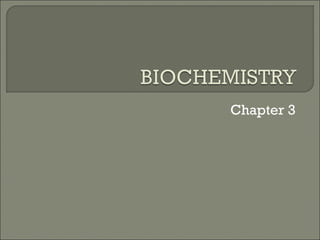
Ch 3 ppt 2010
- 1. Chapter 3
- 2. Most of the molecules from which living organisms are made are based on the element carbon Carbon’s ability to form large and complex molecules has contributed to the great diversity of life
- 3. Organic compounds – compounds made primarily of carbon atoms Why is there such a variety of carbon compounds? • Four valence electrons • Carbon readily bonds with other carbon atoms, forming straight chains, branched chains, or rings
- 5. Single bond – one pair of electrons shared Double bond – two pairs of electrons shared Triple bond – three pairs of electrons shared
- 6. Functional Groups – clusters of atoms in organic compounds that influence the characteristics of the molecules they compose and the chemical reactions the molecules undergo
- 8. Monomers – small, simple molecules Polymers – molecules that consist of repeated, linked units Large polymers are called macromolecules
- 9. Monomers link to form polymers through a chemical reaction called a condensation reaction • Each time a monomer is added to a polymer, a water molecule is released
- 10. Living things also must break down polymers In a hydrolysis reaction, water is used to break down a polymer
- 11. Life’s processes require a constant supply of energy Energy is available in certain compounds that store energy in their structure • Common compound is ATP (adenosine triphosphate)
- 12. Covalent bonds between phosphate groups are easy to break Every time a bond is broken, energy is released The cell uses this energy to drive chemical reactions that allow organisms to function